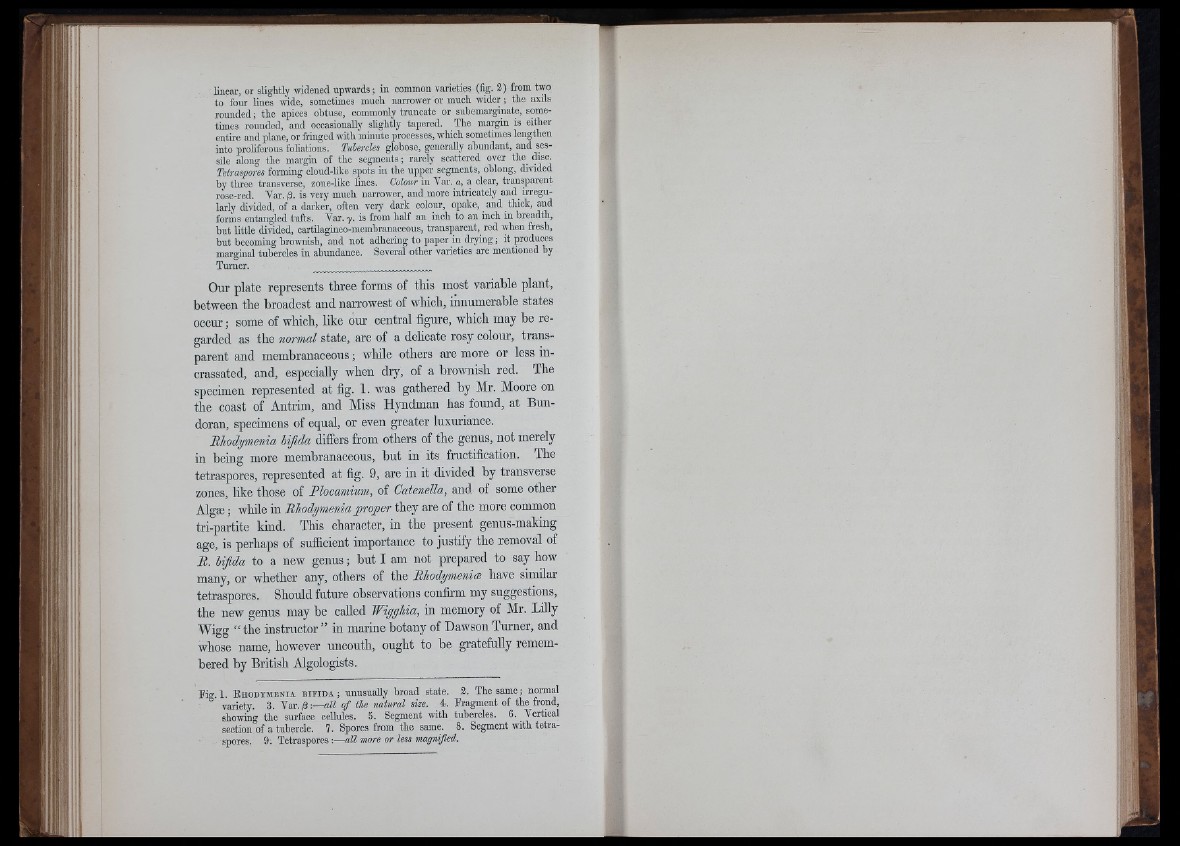
i Iü
i :■
'¡r
1
f-llii
P i
G,: il.
f .« . ‘ i i
r l .
linear, or slightly widened upwards; in common varieties (fig. 2) from two
to fom’ lines wide, sometimes much narrower or much wider; the axils
rounded; the apices obtuse, commonly truncate or subemarginate, sometimes
rounded, and occasionally slightly tapered. The margin is either
entu-e and plane, or fringed with minute processes, which sometimes lengthen
into proliferous foliations. Tubercles globose, generally abundant, and sessile
along the margin of tbe segments; rarely scattered over the disc.
Tetraspores foming cloud-like spots in the upper segments, oblong, divided
by tlu-ee transverse, zone-like lines. Colour in Var. a, a clear, transparent
rose-red. Var. is very much narrower, and more intricately and irregularly
divided, of a darker, often very dark colour, opake, and thick, and
forms entangled tufts. Vm. y. is from half an inch to an inch in breadth,
but httle divided, cartilagineo-membranaceous, transparent, red when fresh,
but becoming brownish, and not adhering to paper in drying; it produces
marginal tubercles in abundance. Several other varieties are mentioned by
Turner.
Oxir plate represents three forms of this most variable plant,
between the broadest and narrowest of which, innumerable states
occur; some of which, like our central figure, which may be regarded
as the normal state, are of a delicate rosy colour, transparent
and membranaceous; while others are more or less incrassated,
and, especially when dry, of a brownish red. The
specimen represented at fig. 1. was gathered by Mr. Moore on
the coast of Antrim, and Miss Hyndman has found, at Bun-
doran, specimens of equal, or even greater luxuriance.
Bliodymenia bifida differs from others of the genus, not merely
in being more membranaceous, but in its fructification. The
tetraspores, represented at fig. 9, are in it divided by transverse
zones, like those of Blocamium, of Catenella, and of some other
Algae; while in Bliodymenia proper they are of the more common
tri-partite kind. This character, in the present genus-making
age, is perhaps of sufficient importance to justify the removal of
B. bifida to a new genus; but I am not prepared to say how
many, or whether any, others of the BhodymenicB have similar
tetraspores. Should future observations confirm my suggestions,
the new genus may be called Wigghia, in memory of Mr. Lilly
Wigg “ the instructor ” in marine botany of Dawson Turner, and
whose name, however uncouth, ought to be gratefully remembered
by British Algologists.
Kg. 1. R h o d ym b n ia b i f i d a ; tmusually broad state. 2 . The same; normal
variety. 3. Rax. all o f tie natural size. 4. Fragment of the frond,
showing the surface ceUules. 5. Segment with tubercles. 6. Vertical
section of a tubercle. 7. Spores from the same.^ 8. Segment with tetraspores.
9 . Tetraspores :— all more or less i
A